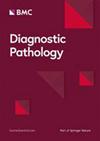Squamous cell carcinoma initially occurring on the tongue dorsum: a case series report with molecular analysis
IF 2.4
3区 医学
Q2 PATHOLOGY
引用次数: 0
Abstract
Squamous cell carcinoma (SCC) of the dorsum of the tongue is extremely rare, and it clinically resembles various benign lesions. Somatic mutations in TP53 and some driver genes were implicated in the development of SCC; however, the somatic genetic characteristics of dorsal tongue SCC remain unknown. With a detailed analysis of gene mutations in dorsal tongue SCC, we aimed to better understand its biology. Four cases of SCC initially occurring on the tongue dorsum were evaluated for clinical and histological findings and immunohistochemical expression of p53 and p16. Gene mutations were analyzed using next-generation sequencing with a custom panel of driver genes. We retrospectively investigated 557 cases of tongue SCC, and only four cases of SCC initially occurred on the tongue dorsum. The four patients (cases 1–4) were one woman and three men with a mean age of 53.75 years (range: 15–74 years). Histological analysis revealed well-differentiated SCC. Through molecular analysis, we identified pathogenic somatic mutations, namely, TP53 p.C176F (c.527G > T) in case 3 and TP53 p.R282W (c.844 C > T) in case 4. No pathogenic variants were identified in the PI3K/AKT or RAS/RAF pathways. The p53 immunohistochemical examination revealed a wild-type expression pattern in cases 1–3 and strong expression in case 4. The results of p16 immunostaining were negative in all cases. We described four previously unreported genetic characteristics of dorsal tongue SCC. Somatic TP53 mutations may contribute to the development of a subset of dorsal tongue SCC; however, more cases with genetic analysis need to be accumulated.最初发生在舌背的鳞状细胞癌:带分子分析的病例系列报告
舌背鳞状细胞癌(SCC)极为罕见,临床上与各种良性病变相似。TP53和一些驱动基因的体细胞突变与SCC的发生有关,但舌背SCC的体细胞遗传特征仍不清楚。通过详细分析舌背SCC的基因突变,我们旨在更好地了解其生物学特性。我们对四例最初发生在舌背的 SCC 进行了临床和组织学检查,并对 p53 和 p16 的免疫组化表达进行了评估。基因突变的分析采用了新一代测序技术和定制的驱动基因面板。我们回顾性调查了557例舌SCC病例,只有4例SCC最初发生在舌背。这四例患者(病例 1-4)为一女三男,平均年龄 53.75 岁(15-74 岁)。组织学分析显示,SCC 分化良好。通过分子分析,我们发现了致病性体细胞突变,即病例 3 中的 TP53 p.C176F (c.527G > T) 和病例 4 中的 TP53 p.R282W (c.844 C > T)。在 PI3K/AKT 或 RAS/RAF 通路中未发现致病变异。p53 免疫组化检查显示,1-3 例为野生型表达模式,4 例为强表达模式。所有病例的 p16 免疫染色结果均为阴性。我们描述了四种以前未报道过的舌背 SCC 遗传特征。体细胞TP53突变可能是导致部分舌背SCC发病的原因之一;但是,还需要积累更多的遗传分析病例。
本文章由计算机程序翻译,如有差异,请以英文原文为准。
求助全文
约1分钟内获得全文
求助全文
来源期刊

Diagnostic Pathology
医学-病理学
CiteScore
4.60
自引率
0.00%
发文量
93
审稿时长
1 months
期刊介绍:
Diagnostic Pathology is an open access, peer-reviewed, online journal that considers research in surgical and clinical pathology, immunology, and biology, with a special focus on cutting-edge approaches in diagnostic pathology and tissue-based therapy. The journal covers all aspects of surgical pathology, including classic diagnostic pathology, prognosis-related diagnosis (tumor stages, prognosis markers, such as MIB-percentage, hormone receptors, etc.), and therapy-related findings. The journal also focuses on the technological aspects of pathology, including molecular biology techniques, morphometry aspects (stereology, DNA analysis, syntactic structure analysis), communication aspects (telecommunication, virtual microscopy, virtual pathology institutions, etc.), and electronic education and quality assurance (for example interactive publication, on-line references with automated updating, etc.).
 求助内容:
求助内容: 应助结果提醒方式:
应助结果提醒方式:


